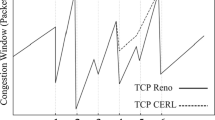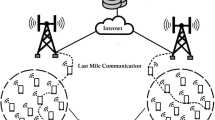Abstract
One major yet unsolved problem in wired-cum-wireless networks is the classification of losses, which might result from wireless temporary interferences or from network congestion. The transport protocol response to losses should be different for these two cases. If the transmission uses existing protocols like TCP, the losses are always classified as congestion losses by sender, causing reduced throughput. In wired networks, ECN (Explicit Congestion Notification) can be used to control the congestion through active queue management such as RED (Random Early Detection). It can also be used to solve the transport protocol misreaction over wireless networks. This paper proposes a loss differentiation method (RELD), based on ECN signaling and RTT (Round Trip Time), and applied to TCPlike. TCPlike is one of the three current congestion controls present in the new transport protocol DCCP (Datagram Congestion Control Protocol). Our simulations, using a more realistic simulated loss error model for wireless networks, show that RELD optimizes congestion control and therefore increases the performance of transport protocols over wireless networks, leading to an average performance gain ranging from 10% to 15%.
Similar content being viewed by others
Explore related subjects
Discover the latest articles, news and stories from top researchers in related subjects.References
Balakrishnan, H., & Katz, R. (1998). Explicit loss notification and wireless web performance. In IEEE GLOBECOM global Internet.
Balakrishnan, H., Seshan, S., & Katz, R. H. (1995). Improving reliable transport and handoff performance in cellular wireless networks. Wireless Networks, 1(4), 469–481.
Balakrishnan, H., Padmanabhan, V. N., Seshan, S., & Katz, R. H. (1997). A comparison of mechanisms for improving TCP performance over wireless links. IEEE/ACM Transactions on Networking, 5(6), 756–769.
Barman, D., & Matta, I. (2002). Effectiveness of loss labeling in improving TCP performance in wired/wireless networks. In ICNP (pp. 2–11). Los Alamitos: IEEE Computer Society.
Biaz, S., & Vaidya, N. H. (1999). Discriminating congestion losses from wireless losses using inter-arrival times at the receiver. In IEEE symposium ASSET (pp. 10–17).
Biaz, S., & Wang, X. (2004). Can ECN be used to differentiate congestion losses from wireless losses? Tech. Rep. CSSE04-04, Auburn University.
Biaz, S., & Wang, X. (2004). RED for improving TCP over wireless networks. In ICWN: international conference on wireless networks (pp. 628–636).
Boukerche, A., Jia, G., & Pazzi, R. W. N. (2007). Performance evaluation of packet loss differentiation algorithms for wireless networks. In PM2HW2N: performance monitoring and measurement of heterogeneous wireless and wired networks (pp. 50–52). New York: ACM.
Cen, S., Cosman, P. C., & Voelker, G. M. (2003). End-to-end differentiation of congestion and wireless losses. IEEE/ACM Transactions on Networking, 11(5), 703–717.
Chou, C. F., Hsu, M. W., & Lin, C. J. (2006). A trend-loss-density-based differential scheme in wired-cum-wireless networks. In: IWCMC: international conference on wireless communications and mobile computing (pp. 239–244).
Dhoutaut, D., & Spies, F. (2007). Adding geographical interferences into the shadowing pattern model for vehicular ad hoc networks simulations. In ITST ’07. 7th international conference on intelligent transport systems communications.
Dhoutaut, D., Régis, A., & Spies, F. (2006). Impact of radio propagation models in vehicular ad hoc networks simulations. In VANET ’06: proceedings of the 3rd international workshop on vehicular ad hoc networks (pp. 40–49). New York: ACM, doi:10.1007/s11235-011-9495-3.
Eude, N., Ducourthial, B., & Shawsky, M. (2005). Enhancing ns-2 simulator for high mobility ad hoc networks in car-to-car communication context. In Proceedings of the 7th IFIP international conference on mobile and wireless communications networks (MWCN 2005), Morocco.
Floyd, S., & Kohler, E. (2006). Profile for datagram congestion control protocol (DCCP) congestion control ID 2: TCP-like congestion control. RFC 4341.
Floyd, S., Kohler, E., & Padhye, J. (2006). Profile for datagram congestion control protocol (DCCP) congestion control ID 3: TCP-friendly rate control (TFRC). RFC 4342.
Friis, H. (1946). A note on a simple transmission formula. In Proc. IRE 34.
Kelly, F. (2001). Mathematical modelling of the Internet. In Mathematics unlimited—2001 and beyond (pp. 685–702). Berlin: Springer.
Kohler, E., Handley, M., & Floyd, S. (2006). Datagram congestion control protocol (DCCP). RFC 4340.
Mattsson, N. E. (2004). A DCCP module for ns-2. Master’s thesis, Luleå University of Technology.
ns (2009). The Network Simulator NS-2 (v2.34). http://www.isi.edu/nsnam/ns/.
Park, M. K., Sihn, K. H., & Jeong, J. H. (2006). A statistical method of packet loss type discrimination in wired-wireless network. In CCNC: IEEE consumer communications & networking conference.
Parsa, C., & Garcia-Luna-Aceves, J. J. (1999). Improving TCP congestion control over internets with heterogeneous transmission media. In ICNP: IEEE international conference on network protocols (pp. 213–221).
Postel, J. (1980). User datagram protocol. RFC 768.
Postel, J. (1981). Transmission control protocol. RFC 793.
Ramadan, W., Dedu, E., & Bourgeois, J. (2009). EcnLD, ECN loss differentiation to optimize the performance of transport protocols on wireless networks. In International conference on ultra modern telecommunications & workshops (ICUMT), WMCNT workshop (Vol. 1, pp. 1–6). Saint Petersburg: IEEE.
Ramakrishnan, K., Floyd, S., & Black, D. (2001). The addition of explicit congestion notification (ECN) to IP. RFC 3168.
De La Roche, G., Rebeyrortte, R., Jaffrès Runser, K., & Gorce, J. M. (2005). A new strategy for indoor propagation fast computation with MR-FDPF algorithm. In: Acta Press (ed.) Antennas, radar and wave propagation, IASTED, Banff Canada. http://hal.inria.fr/inria-00405192/en/.
Schulzrinne, H., Casner, S., Frederick, R., & Jacobson, V., (2003). RTP: a transport protocol for real-time applications. RFC 3550.
Stepanov, I., Herrscher, D., & Rothermel, K. (2005). On the impact of radio propagation models on Manet simulation results. In Proceedings of the 7th IFIP international conference on mobile and wireless communication networks, MWCN 2005, Marrakech, Morocco.
Tobe, Y., Tamura, Y., Molano, A., Ghosh, S., & Tokuda, H. (2000). Achieving moderate fairness for UDP flows by path-status classification. In LCN: IEEE Local computer networks (p. 252).
Ye, G., Saadawi, T., & Lee, M. J. (2004). Improving stream control transmission protocol performance over lossy links. IEEE Journal on Selected Areas in Communications, 22(4), 727–736.
Yin, J., ElBatt, T., Yeung, G., Ryu, B., Habermas, S., Krishnan, H., & Talty, T. (2004). Performance evaluation of safety applications over dsrc vehicular ad hoc networks. In Proceedings of VANET (pp. 1–9).
Author information
Authors and Affiliations
Corresponding author
Rights and permissions
About this article
Cite this article
Ramadan, W., Dedu, E., Dhoutaut, D. et al. RELD, RTT ECN Loss Differentiation to optimize the performance of transport protocols on wireless networks. Telecommun Syst 52, 1797–1817 (2013). https://doi.org/10.1007/s11235-011-9495-3
Published:
Issue Date:
DOI: https://doi.org/10.1007/s11235-011-9495-3




